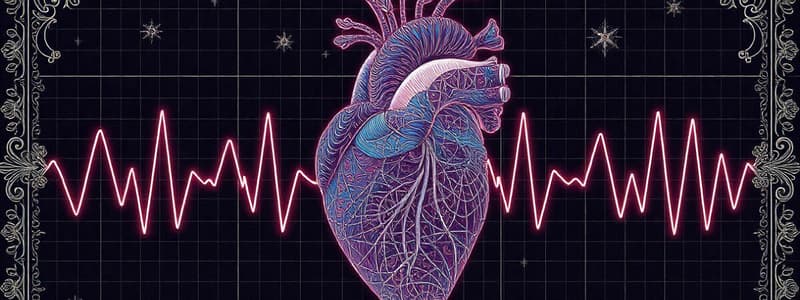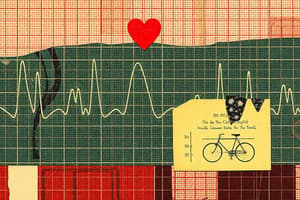Podcast
Questions and Answers
What is the name of the process used to monitor the electrical activity of the heart?
What is the name of the process used to monitor the electrical activity of the heart?
- Electromyography (EMG)
- Echocardiogram (ECHO)
- Electroencephalography (EEG)
- Electrocardiography (ECG) (correct)
On an ECG trace, what does the P wave indicate?
On an ECG trace, what does the P wave indicate?
- Contraction of the atria (correct)
- Ventricular relaxation
- Contraction of the ventricles
- Ventricular fibrillation
What does the QRS complex on an ECG trace represent?
What does the QRS complex on an ECG trace represent?
- Atrial contraction
- Ventricular relaxation
- Atrial relaxation
- Ventricular contraction (correct)
What part of the ECG trace corresponds to the start of ventricular relaxation?
What part of the ECG trace corresponds to the start of ventricular relaxation?
Which condition is characterized by an irregular heartbeat that has lost its rhythm?
Which condition is characterized by an irregular heartbeat that has lost its rhythm?
What causes the 'lub' sound in the heartbeat?
What causes the 'lub' sound in the heartbeat?
What tool do doctors use to listen to heart sounds?
What tool do doctors use to listen to heart sounds?
What does a pulse indicate?
What does a pulse indicate?
Where can you easily feel a pulse?
Where can you easily feel a pulse?
What does a lower resting pulse rate generally indicate?
What does a lower resting pulse rate generally indicate?
What causes the 'lub' sound during the cardiac cycle?
What causes the 'lub' sound during the cardiac cycle?
What happens during ventricular systole?
What happens during ventricular systole?
What is the function of the valves in the heart?
What is the function of the valves in the heart?
What happens to the atria during ventricular systole?
What happens to the atria during ventricular systole?
Which of the following is the correct sequence of events in the cardiac cycle?
Which of the following is the correct sequence of events in the cardiac cycle?
What is indicated by an electrocardiogram (ECG)?
What is indicated by an electrocardiogram (ECG)?
What happens during diastole?
What happens during diastole?
What is the function of the semi-lunar valves?
What is the function of the semi-lunar valves?
What is the approximate duration of atrial systole?
What is the approximate duration of atrial systole?
How is heart activity typically monitored?
How is heart activity typically monitored?
What is the primary process involved in coronary heart disease (CHD)?
What is the primary process involved in coronary heart disease (CHD)?
What is the term for chest pain caused by reduced blood flow to the heart?
What is the term for chest pain caused by reduced blood flow to the heart?
Which of the following is a risk factor for coronary heart disease related to lifestyle?
Which of the following is a risk factor for coronary heart disease related to lifestyle?
What type of fat intake should be reduced to lower the risk of CHD?
What type of fat intake should be reduced to lower the risk of CHD?
Which substance in cigarette smoke increases the rate of cholesterol deposit in arteries?
Which substance in cigarette smoke increases the rate of cholesterol deposit in arteries?
What is the term for the build-up of cholesterol deposits on the inner walls of arteries?
What is the term for the build-up of cholesterol deposits on the inner walls of arteries?
Which dietary component helps to reduce high blood pressure and cholesterol?
Which dietary component helps to reduce high blood pressure and cholesterol?
What can too much sugar in the diet cause, increasing risk of CHD?
What can too much sugar in the diet cause, increasing risk of CHD?
What is the term for a blood clot in a coronary artery?
What is the term for a blood clot in a coronary artery?
Which of these is considered a healthy source of unsaturated fats?
Which of these is considered a healthy source of unsaturated fats?
Which of these is a risk factor for Coronary Heart Disease (CHD)?
Which of these is a risk factor for Coronary Heart Disease (CHD)?
Which dietary change will reduce the risk of Coronary Heart Disease (CHD)?
Which dietary change will reduce the risk of Coronary Heart Disease (CHD)?
What component of cigarette smoke contributes to cholesterol buildup in arteries?
What component of cigarette smoke contributes to cholesterol buildup in arteries?
What age group is most likely to die of Coronary Heart Disease (CHD)?
What age group is most likely to die of Coronary Heart Disease (CHD)?
What kind of dietary fat is recommended to reduce the risk of Coronary Heart Disease (CHD)?
What kind of dietary fat is recommended to reduce the risk of Coronary Heart Disease (CHD)?
Which of the following is a benefit of regular exercise in relation to heart health?
Which of the following is a benefit of regular exercise in relation to heart health?
Which of the following is true concerning the risk of heart disease and gender?
Which of the following is true concerning the risk of heart disease and gender?
Besides diet and exercise, what is another modifiable risk factor for CHD?
Besides diet and exercise, what is another modifiable risk factor for CHD?
Flashcards
What is an ECG?
What is an ECG?
A test that monitors electrical activity in the heart muscle cells.
What does the 'P' wave on an ECG represent?
What does the 'P' wave on an ECG represent?
Shows the contraction of the atria.
What does the 'QRS' complex on an ECG represent?
What does the 'QRS' complex on an ECG represent?
Ventricular contraction.
What does the 'T' wave on an ECG represent?
What does the 'T' wave on an ECG represent?
Signup and view all the flashcards
What is fibrillation?
What is fibrillation?
Signup and view all the flashcards
'Lub' Heart Sound
'Lub' Heart Sound
Signup and view all the flashcards
'Dub' Heart Sound
'Dub' Heart Sound
Signup and view all the flashcards
Stethoscope
Stethoscope
Signup and view all the flashcards
Pulse
Pulse
Signup and view all the flashcards
Pulse Rate
Pulse Rate
Signup and view all the flashcards
Cardiac Cycle
Cardiac Cycle
Signup and view all the flashcards
Atrial Systole
Atrial Systole
Signup and view all the flashcards
Ventricular Systole
Ventricular Systole
Signup and view all the flashcards
Diastole
Diastole
Signup and view all the flashcards
Electrocardiogram (ECG)
Electrocardiogram (ECG)
Signup and view all the flashcards
Arteries
Arteries
Signup and view all the flashcards
Veins
Veins
Signup and view all the flashcards
Heart Function
Heart Function
Signup and view all the flashcards
Measuring Heart Activity
Measuring Heart Activity
Signup and view all the flashcards
Coronary Heart Disease (CHD)
Coronary Heart Disease (CHD)
Signup and view all the flashcards
Atherosclerosis
Atherosclerosis
Signup and view all the flashcards
Coronary Thrombosis
Coronary Thrombosis
Signup and view all the flashcards
Angina
Angina
Signup and view all the flashcards
Heart Attack
Heart Attack
Signup and view all the flashcards
Heart Failure
Heart Failure
Signup and view all the flashcards
CHD Risk: Diet
CHD Risk: Diet
Signup and view all the flashcards
CHD Risk: Sedentary Lifestyle
CHD Risk: Sedentary Lifestyle
Signup and view all the flashcards
CHD Risk: Smoking
CHD Risk: Smoking
Signup and view all the flashcards
Diet to Reduce CHD Risk
Diet to Reduce CHD Risk
Signup and view all the flashcards
Diet and CHD Risk
Diet and CHD Risk
Signup and view all the flashcards
Sedentary Lifestyle
Sedentary Lifestyle
Signup and view all the flashcards
Stress and CHD
Stress and CHD
Signup and view all the flashcards
Smoking and CHD
Smoking and CHD
Signup and view all the flashcards
Genetic Predisposition
Genetic Predisposition
Signup and view all the flashcards
Gender and CHD
Gender and CHD
Signup and view all the flashcards
Healthy Diet & CHD
Healthy Diet & CHD
Signup and view all the flashcards
Exercise and CHD
Exercise and CHD
Signup and view all the flashcards




